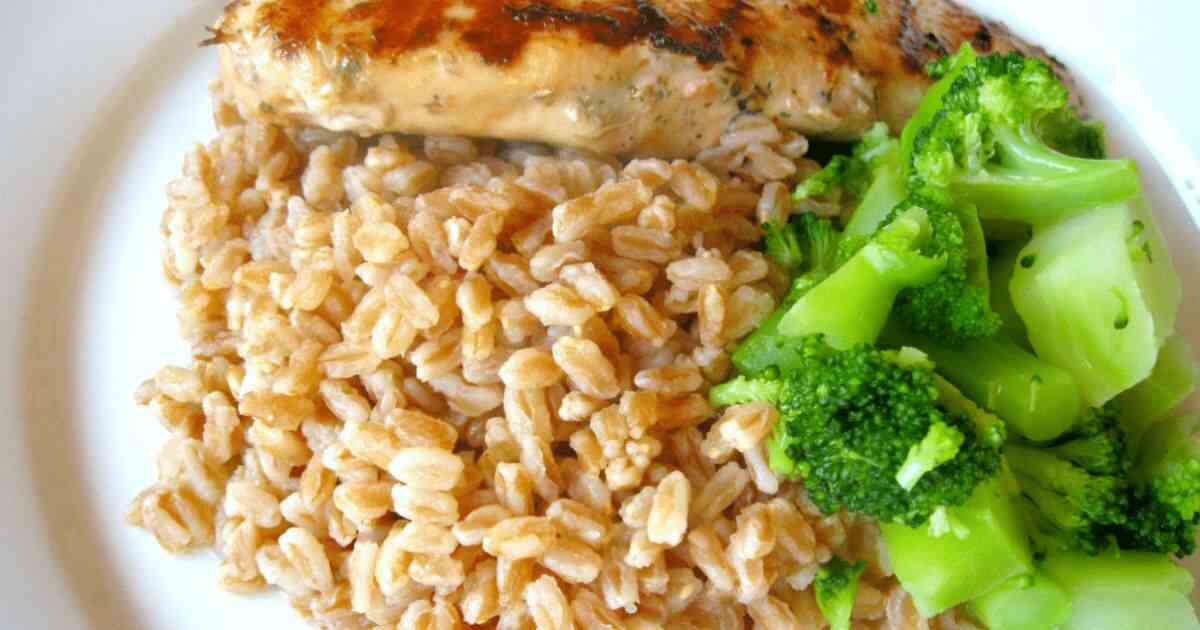Farro Nutrition Facts is a nutritious ancient grain packed with protein, fiber, and minerals. In addition to being a high-quality source of carbohydrates, it also contains antioxidants and anti-inflammatory properties.
Farro Nutrition is one of the oldest cultivated grains in the world and has been a staple food in various cultures for thousands of years. This ancient grain is a type of wheat that is typically grown in Mediterranean countries such as Italy and greece.
Farro Nutrition Facts has a nutty flavor and chewy texture, making it a versatile ingredient in a variety of dishes. It can be used in soups, salads, and even as a substitute for rice in sushi. Farro is highly nutritious and contains several health benefits. It is high in protein and fiber, which helps to promote satiety and regulate blood sugar levels. Farro is also a good source of minerals such as magnesium, iron, and zinc.
Additionally, it contains antioxidants and anti-inflammatory properties that can help to reduce the risk of chronic diseases such as heart disease, diabetes, and certain cancers. Overall, incorporating farro into your diet is a great way to add variety and nutrition to your meals. With its delicious taste and impressive health benefits, it’s no wonder that this ancient grain has stood the test of time and remains a popular choice among health-conscious eaters today.
What Is Farro Nutrition?

Farro is one of the oldest grains known to humans, and for centuries has been a staple food in many parts of the world. This ancient grain is a type of wheat that is commonly found in mediterranean, middle eastern, and ethiopian cuisines.
In recent years, however, farro has become a popular ingredient in many dishes, thanks to its delicious taste and unique nutritional benefits. We explore the many aspects of farro, from its definition and origin, to its nutritional value and different types.
Define Farro And Its Origin:
- Farro Nutrition is a type of wheat that can refer to three different species of grains: Emmer, spelt, and einkorn.
- Emmer is the most common type of farro, and it is believed to have originated in the fertile crescent, an area that includes modern-day syria and iraq.
- Farro Nutrition was one of the first crops that humans domesticated, and it has been cultivated for over 10,000 years.
- Farro has a nutty flavor and a chewy texture that makes it a perfect ingredient in many dishes, including salads, soups, and stews.
Compare Farro To Other Grains:
- Farro is higher in protein, fiber, and b vitamins than many other grains, such as rice and quinoa.
- Farro has a lower glycemic index than some other grains, meaning it doesn’t cause a rapid spike in blood sugar levels.
- Unlike some other grains, farro is an excellent source of antioxidants, which can help protect the body against free radicals that can cause damage to cells.
Discuss The Different Types Of Farro:
- Emmer farro: This is the most common type of farro, and it has a tough outer hull that needs to be removed before cooking. Emmer farro has a rich, nutty flavor and a chewy texture.
- Spelt farro: This type of farro is similar to emmer, but it has a milder taste and a softer texture. Spelt farro is easier to digest than emmer farro.
- Einkorn farro: Einkorn farro has a delicate, nutty flavor and a softer texture than emmer and spelled farro. It is also the most nutritious type of Farro Nutrition fact, with higher levels of protein and antioxidants.
Farro Nutritionfact is a versatile and nutritious grain that can enhance the flavor and nutritional value of any dish. Whether you choose emmer, spelt, or einkorn farro, you are sure to enjoy the unique taste and health benefits of this ancient grain.
So, go ahead and try incorporating farro into your diet and taste the goodness!
Discover The Amazing Farro Nutrition Facts
Farro Nutrition Facts is a type of ancient wheat that has been around for thousands of years. This grain has recently become popular for its unique nutty flavor and versatility in dishes. However, the benefits of farro go beyond taste and can make a significant difference in one’s health.
We will discover the amazing farro nutrition facts and uncover its secret nutritional boost.
Detailed Breakdown Of The Nutritional Benefits Of Farro
Farro is packed with various nutrients, a reason why it has become a favorite food for health enthusiasts. Here are some of the significant nutritional benefits:
- Farro nutrition facts contain high levels of fiber, which aids in digestion, lowers cholesterol levels and prevents constipation.
- With a low glycemic index, farro is an excellent food for maintaining healthy blood sugar levels.
- Farro is an excellent source of protein and amino acids, making it a favorite food among athletes and vegans.
- The grain is also rich in complex b vitamins like niacin, thiamin, and riboflavin that keep the nervous system healthy.
- It also contains magnesium, iron, selenium, and zinc, which play a significant role in promoting bone health and boosting the immune system.
Highlight The Vitamin And Mineral Content
Farro is a vitamin and mineral powerhouse that nourishes the body and promotes optimal health. Here are some of the vitamins and minerals you get from eating farro:
- Vitamin b3 or niacin: For proper brain function and healthy circulation.
- Vitamin b1 or thiamin: For energy metabolism and nerve function.
- Vitamin b2 or riboflavin: For healthy eyes, skin, and proper blood cell production.
- Iron: For the formation of hemoglobin, the oxygen-carrying component of blood.
- Magnesium: For maintaining healthy bones, muscles, and nerves.
- Zinc: For a healthy immune system and wound healing.
- Selenium: For protecting the body against oxidative damage.
Discuss The Role Of Farro Nutrition Facts In Maintaining A Healthy Lifestyle
Making farro a part of your diet can help you live a healthier life. Here are some of the ways farro can help:
- Farro nutrition facts has a low glycemic index, which means it doesn’t cause spikes in blood sugar levels, making it an excellent option for diabetic patients or those with insulin resistance.
- Farro Nutrition is a high fiber food that keeps you feeling full for longer while promoting healthy digestion and reducing the risk of certain diseases such as colon cancer.
- Farro contains complex carbs that provide the body with energy for proper body function and physical activities.
- It has a balance of macronutrients that promote weight loss and overall health.
- Farro is a versatile grain that can be used in various dishes, from salads to soups, to desserts, ensuring that you never tire of eating it!
Uncovering The Secret Nutritional Boost In Farro Nutrition Facts
Farro is an ancient grain that continues to gain popularity due to its nutritional content and versatility in dishes. The grain is an excellent source of fiber, amino acids, vitamins, and minerals, contributing to various health benefits. By incorporating Farro nutrition facts into diets, people can take advantage of its exceptional nutritional value and maintain healthy lifestyles.
Cooking With Farro
Farro Nutrition Facts – Cooking With Farro
Farro is an ancient wheat grain that has recently gained popularity as a healthy and versatile ingredient in many dishes. It offers several health benefits, making it the perfect addition to any meal. In this section, we will explore how to cook with farro, provide recipe ideas, and dive into the versatility of farro in different types of cuisines.
Basic Instructions On How To Cook Farro
Cooking farro is quite straightforward and requires only a few simple steps. Here is a basic guide to cooking farro:
- Rinse the farro thoroughly to remove any dirt or debris.
- Boil two cups of water for every cup of farro.
- Add the farro to the boiling water and stir.
- Reduce the heat to a simmer, cover the pot, and cook for 25-30 minutes until the farro is tender.
- Drain any excess water.
Recipe Ideas On How To Incorporate Farro Into Meals
Farro is incredibly versatile and can be used in both sweet and savory dishes. Here are a few recipe ideas to get you started:
- Farro salad: Combine cooked farro with diced tomatoes, cucumbers, red onion, and feta cheese. Dress with olive oil, lemon juice, and salt and pepper to taste.
- Farro risotto: Swap out rice for farro in your favorite risotto recipe for a nuttier and more flavorful dish.
- Farro breakfast bowl: Toss cooked farro with berries, honey, and greek yogurt for a nutritious and filling breakfast.
Discuss The Versatility Of Farro In Different Types Of Cuisines
Farro is a versatile ingredient that can be used in a variety of cuisines. Its nutty flavor and hearty texture make it the perfect addition to many dishes, including:
- Italian cuisine: Farro is a common ingredient in italian cuisine and is often used in pasta dishes and risottos.
- Middle eastern cuisine: Farro is commonly used in middle eastern cuisine in salads, pilafs, and stews.
- Mediterranean cuisine: Farro can be found in many mediterranean dishes, including tabbouleh and falafel.
- American cuisine: Farro has become increasingly popular in american cuisine and is often used in grain bowls and salads.
Farro is a healthy and versatile ingredient that can be used in a wide range of dishes and cuisines. Whether you’re looking to add more nutrients to your meals or simply want to switch up your cooking routine, farro is an excellent choice.
So, go ahead and experiment with this ancient grain to create delicious and Farro Nutrition Facts dishes!
Farro Nutrition Vs Other Grains
Farro Nutrition Facts: Farro Vs Other Grains
Compared to other grains, farro is a nutritional powerhouse that offers numerous health benefits while also being a delicious grain to include in your diet.
Compare Farro nutrition To Other Grains In Terms Of Nutrition
When compared to other grains like rice, wheat, and quinoa, farro generally contains more nutrients and fiber. Here’s how it stacks up against other grains:
- Farro contains more fiber than brown or white rice, making it an excellent option for promoting digestive health and preventing constipation.
- Farro has a higher protein content than quinoa, which is often praised for its protein content and is therefore a great option for vegan or vegetarian diets.
- Farro nutrition is a good source of iron, providing nearly 15% of the recommended daily intake of this important mineral. This is especially important for those who are pregnant or have a history of anemia.
- Farro boasts more zinc and magnesium than wheat, which helps to support the immune system and regulate blood sugar levels.
Benefits Of Choosing Farro Over Other Grains
There are plenty of reasons to choose farro over other grains when it comes to health and nutrition. Here are some benefits to consider:
- The high fiber content of farro can help to promote feelings of fullness, making it a great option for weight management.
- Farro is packed with antioxidants that help to reduce inflammation in the body and protect against chronic diseases.
- Farro is a low-glycemic index (gi) food, meaning it releases sugar into the bloodstream more slowly. This can help to prevent blood sugar spikes and crashes, making it a good option for those with diabetes.
- Farro is a versatile grain that can be used in a variety of dishes, from salads to soups to grain bowls. Its unique texture and nutty flavor make it a delicious addition to any recipe.
There are numerous reasons to add farro to your diet. Its nutritional value combined with its delicious taste and versatility make it a great option for promoting health and wellness. Whether you’re looking to manage your weight, promote digestive health, or simply try something new, farro is a fantastic grain to include in your diet.
Frequently Asked Questions Of Farro Nutrition Facts
What Is Farro?
Farro is a type of ancient wheat grain, popularly used in italian cuisine. It is a good source of fiber, protein, and other essential nutrients.
What Are The Health Benefits Of Eating Farro?
Farro is a highly nutritious grain that is loaded with fiber, protein, vitamins, and minerals. It helps in promoting digestion, reducing the risk of heart disease, and maintaining healthy blood sugar levels.
How To Cook Farro?
Farro can be cooked in various ways like boiling, steaming, or baking. Rinse the farro, then add it to a pot of boiling salted water and cook it for around 20-25 minutes. Drain and rinse the farro and it’s ready to be served.
Is Farro Gluten-Free?
Farro contains gluten, and it is not suitable for people with celiac disease or gluten intolerance. However, some people with mild gluten sensitivity can still tolerate it.
How Does Farro Compare To Other Grains In Terms Of Nutrition?
Farro is richer in nutrients like protein, fiber, and minerals compared to other grains like white rice or quinoa.
Can Farro Be Eaten By Vegans?
Yes, farro is suitable for vegans as it does not contain any animal-based products. It is an excellent source of protein for people following a vegetarian or vegan diet.
Conclusion
Farro is a highly nutritious grain with a rich history that traces back to ancient times. Its impressive nutritional profile, including high fiber, protein, b vitamins, and minerals like iron and magnesium, make it a valuable addition to any diet.
Farro can boost heart health, manage blood sugar, and support digestion. In culinary terms, it is versatile, easy to cook, and can be used in a variety of dishes, from salads and soups to stews and desserts. Its nutty flavor and chewy texture appeal to many taste buds, making it a healthy and delicious alternative to rice, pasta, and other grains.
Overall, incorporating farro into your meals can offer numerous health benefits and add variety to your diet. Start exploring the benefits of farro today and enjoy the delicious and nutritious recipes it has to offer!




